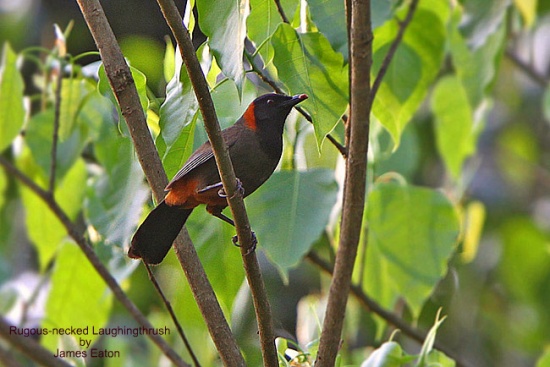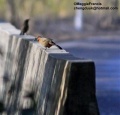- Pterorhinus ruficollis
Dryonastes ruficollis
Garrulax ruficollis
Ianthocincla ruficollis
Identification
22 - 27cm. A small and trim Laughingthrush:
- Dark olive plumage with a dark grey crown
- Face, throat and upper breast blackish
- Post-auricular patch bright chestnut
- Bright chestnut lower belly and vent
- Blackish tail
Sexes similar. Juveniles are less marked with browner plumage and much duller rufous on vent
Similar species
Superficially similar to Rufous-cheeked Laughingthrush but ranges don't overlap and the two species may not even belong to the same genus.
Distribution
From southcentral Nepal east to Bhutan, northeast India, northeast Bangladesh, north Burma and adjacent south China (Tibet, Yunnan).
Locally common, generally rare in Burma and China.
Taxonomy
This is a monotypic species[1].
This species is sometimes placed in the genus Ianthocincla or in Dryonastes.
Habitat
Broadleaf forest, secondary growth, forest edge, also scrub, grass, bamboo-jungle and reeds. Often along streams. Found at 120 - 1645m, up to 2000m in Bhutan.
Behaviour
Diet
Feeds on insects and small molluscs. Takes also berries and seeds, including rice or millet.
Usually seen in groups of up to 30 birds outside breeding season. Forages among low bushes or on the ground.
Breeding
Breeding season March to August. The nest is a compact deep cup made of dry bamboo, other leaves, grasses, roots, weed stems and creeper stems. It's placed in brambles or a bush, some 1 - 1.7m above the ground. Lays 3 - 4 eggs.
Movements
Resident species.
Gallery
Click on photo for larger image
References
- Clements, J. F., T. S. Schulenberg, M. J. Iliff, S. M. Billerman, T. A. Fredericks, B. L. Sullivan, and C. L. Wood. 2019. The eBird/Clements Checklist of Birds of the World: v2019. Downloaded from http://www.birds.cornell.edu/clementschecklist/download/
- Del Hoyo, J, A Elliott, and D Christie, eds. 2007. Handbook of the Birds of the World. Volume 12: Picathartes to Tits and Chickadees. Barcelona: Lynx Edicions. ISBN 978-8496553422
- Rasmussen, PC and JC Anderton. 2005. Birds of South Asia: The Ripley Guide. Barcelona: Lynx Edicions. ISBN 978-8487334672
Recommended Citation
- BirdForum Opus contributors. (2024) Rufous-necked Laughingthrush. In: BirdForum, the forum for wild birds and birding. Retrieved 27 April 2024 from https://www.birdforum.net/opus/Rufous-necked_Laughingthrush
External Links
]]





